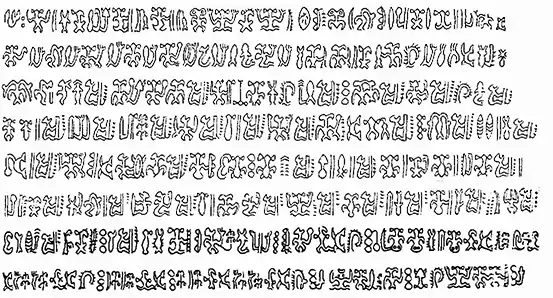.jpg.webp)
Text G of the rongorongo corpus, the smaller of two tablets located in Santiago and therefore also known as the Small Santiago tablet, is one of two dozen surviving rongorongo texts. It may include a short genealogy.
Other names
G is the standard designation, from Barthel (1958). Fischer (1997) refers to it as RR8.
Location
Museo Nacional de Historia Natural, Santiago. Catalog # 5.497 (314).
There are reproductions at the Musée de l'Homme, Paris; Padri dei Sacri Cuori (SSCC), Rome; Museum of Mankind, London; Ibero-American Institute, Berlin; Bishop Museum, Honolulu; Department of Anthropology, National Museum of Natural History, Smithsonian Institution, Washington; American Museum of Natural History, New York; van Hoorebeeck Collection, Belgium; and in Steven Fischer's collection in Auckland.
Description
.jpg.webp)
A beautiful fluted tablet in excellent condition, 32 × 12.1 × 1.8 cm, of Pacific rosewood (Orliac 2005).
Provenance
In 1870 Father Roussel gave tablets G and H to Captain Gana of the Chilean corvette O'Higgins. They remained in the custody of the Chilean navy in Valparaíso until they were sent to the newly established department of archeology at the Museo Nacional de Historia Natural.
Contents
In 1956 Butinov and Knorozov noted that the structure of a sequence of 15 glyphs in Gv6 suggested that it was a genealogy: A son of B, B son of C, C son of D, ... The final glyph 76 in each sequence, which Fischer (1997) sees as a phallus, would thus be a patronymic taxogram and would mark personal names on other tablets, something which Guy (1998) considers to be a reasonable interpretation.
Several scholars have noticed that tablet G contains two structurally very different texts. Most of Gr is paraphrased as text K, while the last line and a half of Gr and the whole of Gv share short phrases with I and T (or at least Ta) but not the rest of the rongorongo corpus (Pozdniakov 1996:290, 299).
Text
Eight lines of glyphs on each side, for ~ 720 glyphs in all.
Harrison (1874:379) noticed that lines Gr3-7 feature a compound glyph, 380.1+3 (a figure on a vertical rod with a garland), repeated 31 times, each followed by up to half a dozen glyphs before the next. He thought that the figure broke the text into sections, each of which contained the name of a chief. Fischer agrees that the appear to be names, and Guy (2001) identifies the garland as a determinative of royalty.
Most of the recto (lines 1-7) is repeated with little change on the younger London tablet; after this the structure of the text changes radically, making the last line and a half of Gr and the whole side of Gv distinct from the rest of the rongorongo corpus. In addition, Pozdniakov found a brief sequence of glyphs that crosses from Gr8 to Gv1, confirming Barthel's reading order.
- Recto

- Recto, as traced by Barthel. The lines have been rearranged to reflect English reading order: Gr1 at top, Gr8 at bottom.

- Recto, as traced by Fischer.
- Verso

- Verso, as traced by Barthel: Gv1 at top, Gv8 at bottom.

- Verso, as traced by Fischer.
Image gallery
.jpg.webp) Recto
Recto.jpg.webp) Recto, color (upside down)
Recto, color (upside down).jpg.webp) Recto, partial, color
Recto, partial, color Recto, glyphs traced
Recto, glyphs traced Recto, illustrated
Recto, illustrated
 Verso
Verso Verso, glyphs traced
Verso, glyphs traced Closeup of recto lines 2 (bottom, partial) to 6 (top)
Closeup of recto lines 2 (bottom, partial) to 6 (top) Closeup of verso lines 3 (bottom) to 7 (top)
Closeup of verso lines 3 (bottom) to 7 (top) Part of verso lines 2 (top) to 7 (bottom)
Part of verso lines 2 (top) to 7 (bottom).jpg.webp) Part of verso line 4
Part of verso line 4 The putative genealogy
The putative genealogy Verso, illustrated
Verso, illustrated
References
- BARTHEL, Thomas S. 1958. Grundlagen zur Entzifferung der Osterinselschrift (Bases for the Decipherment of the Easter Island Script). Hamburg : Cram, de Gruyter.
- FISCHER, Steven Roger. 1997. RongoRongo, the Easter Island Script: History, Traditions, Texts. Oxford and N.Y.: Oxford University Press.
- GUY, Jacques B.M. 1998. "Un prétendu déchiffrement des tablettes de l'île de Pâques" (A purported decipherment of the Easter Island tablets), Journal de la Société des Océanistes 106:57–63.
- GUY, Jacques B.M. 2001. "Le calendrier de la tablette Mamari" (The Calendar of the Mamari Tablet), Bulletin du Centre d'Études sur l'Île de Pâques et la Polynésie 47:1–4.
- HARRISON, John Park. 1874. "The Hieroglyphics of Easter Island". Journal of the Royal Anthropological Institute of Great Britain and Ireland 3:370–383. London.
- ORLIAC, Catherine. 2005. "The Rongorongo Tablets from Easter Island: Botanical Identification and 14C Dating." Archaeology in Oceania 40.3.
- POZDNIAKOV, Konstantin (1996). "Les Bases du Déchiffrement de l'Écriture de l'Ile de Pâques (The Bases of Deciphering the Writing of Easter Island)". Journal de la Société des Océanistes 103 (2): 289–303.